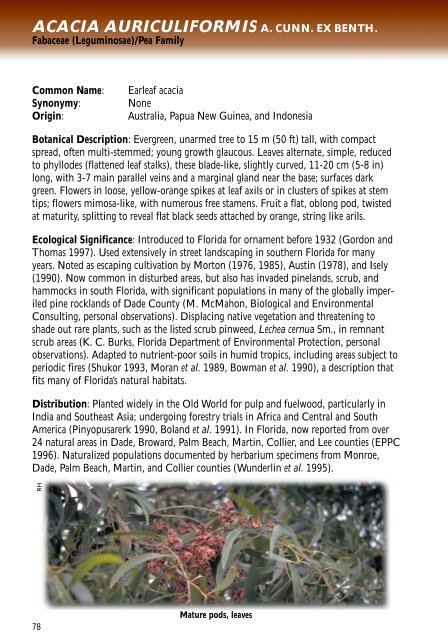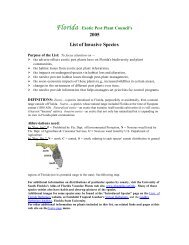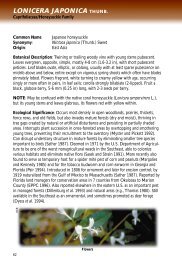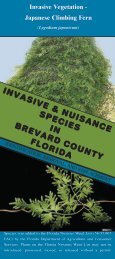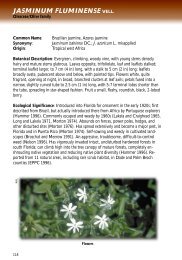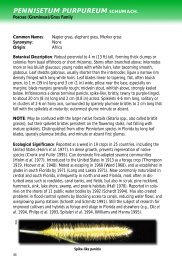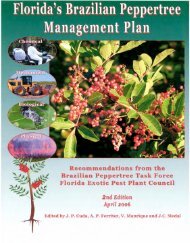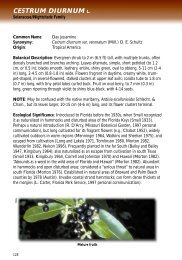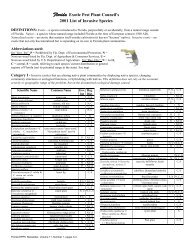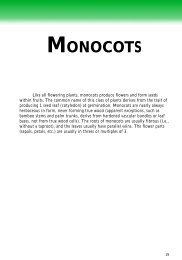Acacia auriculiformis A. Cunn. ex Benth.
Acacia auriculiformis A. Cunn. ex Benth.
Acacia auriculiformis A. Cunn. ex Benth.
You also want an ePaper? Increase the reach of your titles
YUMPU automatically turns print PDFs into web optimized ePapers that Google loves.
<strong>Acacia</strong> <strong>auriculiformis</strong> A. <strong>Cunn</strong>. <strong>ex</strong> <strong>Benth</strong>.Fabaceae (Leguminosae)/Pea FamilyCommon Name:Synonymy:Origin:Earleaf acaciaNoneAustralia, Papua New Guinea, and IndonesiaBotanical Description: Evergreen, unarmed tree to 15 m (50 ft) tall, with compactspread, often multi-stemmed; young growth glaucous. Leaves alternate, simple, reducedto phyllodes (flattened leaf stalks), these blade-like, slightly curved, 11-20 cm (5-8 in)long, with 3-7 main parallel veins and a marginal gland near the base; surfaces darkgreen. Flowers in loose, yellow-orange spikes at leaf axils or in clusters of spikes at stemtips; flowers mimosa-like, with numerous free stamens. Fruit a flat, oblong pod, twistedat maturity, splitting to reveal flat black seeds attached by orange, string like arils.Ecological Significance: Introduced to Florida for ornament before 1932 (Gordon andThomas 1997). Used <strong>ex</strong>tensively in street landscaping in southern Florida for manyyears. Noted as escaping cultivation by Morton (1976, 1985), Austin (1978), and Isely(1990). Now common in disturbed areas, but also has invaded pinelands, scrub, andhammocks in south Florida, with significant populations in many of the globally imperiledpine rocklands of Dade County (M. McMahon, Biological and EnvironmentalConsulting, personal observations). Displacing native vegetation and threatening toshade out rare plants, such as the listed scrub pinweed, Lechea cernua Sm., in remnantscrub areas (K. C. Burks, Florida Department of Environmental Protection, personalobservations). Adapted to nutrient-poor soils in humid tropics, including areas subject toperiodic fires (Shukor 1993, Moran et al. 1989, Bowman et al. 1990), a description thatfits many of Florida’s natural habitats.Distribution: Planted widely in the Old World for pulp and fuelwood, particularly inIndia and Southeast Asia; undergoing forestry trials in Africa and Central and SouthAmerica (Pinyopusarerk 1990, Boland et al. 1991). In Florida, now reported from over24 natural areas in Dade, Broward, Palm Beach, Martin, Collier, and Lee counties (EPPC1996). Naturalized populations documented by herbarium specimens from Monroe,Dade, Palm Beach, Martin, and Collier counties (Wunderlin et al. 1995).RH78Mature pods, leaves
Earleaf acaciaLife History: Grows in zones with average minimum temperatures of -1.2 to -6.6˚C (30to 20˚F) and above (Broschat and Meerow 1991). Particularly drought resistant, but alsotolerates seasonally waterlogged soils; grows in a wide range of soil types and soil pH; andable to withstand competition from cogon grass (see Imperata cylindrica) (Boland et al.1991). Aided in drought resistance and low-nutrient tolerance by mycorrhizal andnitrogen-fixing bacterial associations of the roots (Osonubi et al. 1991, MacDicken andBrewbaker 1989). Found in its native range from dune ridges to river banks (Boland etal. 1991). Flowers in Florida from spring through fall, fruiting prolifically. Seeds dispersedby several bird species, including the introduced European starling (D. F. Austin,Florida Atlantic University, 1997 personal communication). Seed germination hastenedby placing seeds in hot ashes (Bailey and Bailey 1947).AFMBFlowersSapling in scrub preserve,Palm Beach County79


